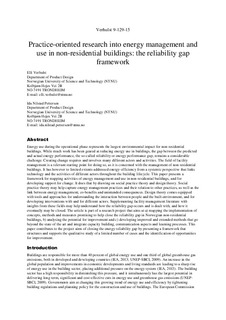| dc.description.abstract | Energy use during the operational phase represents the largest environmental impact for non-residential buildings. While much work has been geared at reducing energy use in buildings, the gap between the predicted and actual energy performance, the so-called reliability or energy performance gap, remains a considerable challenge. Creating change requires and involves many different actors and activities. The field of facility management is a relevant starting point for doing so, as it is concerned with the management of non-residential buildings. It has however to limited extents addressed energy-efficiency from a systemic perspective that links technology and the activities of different actors throughout the building lifecycle. This paper presents a framework for mapping activities of energy management and use in non-residential buildings, and for developing support for change. It does that by drawing on social practice theory and design theory. Social practice theory may help capture energy management practices and their relation to other practices, as well as the link between energy management, co-benefits and unintended consequences. Design theory comes equipped with tools and approaches for understanding the interaction between people and the built environment, and for developing interventions with and for different actors. Supplementing facility management literature with insights from these fields may help understand how the reliability gap occurs and is dealt with, and how it eventually may be closed. The article is part of a research project that aims at a) mapping the implementation of concepts, methods and measures promising to help close the reliability gap in Norwegian non-residential buildings, b) analysing the potential for improvement and c) developing improved and extended methods that go beyond the state of the art and integrate capacity building, communication aspects and learning processes. This paper contributes to the project aims of closing the energy reliability gap by presenting a framework that structures and supports the qualitative study of a limited number of cases and the identification of opportunities for improvement. | nb_NO |
